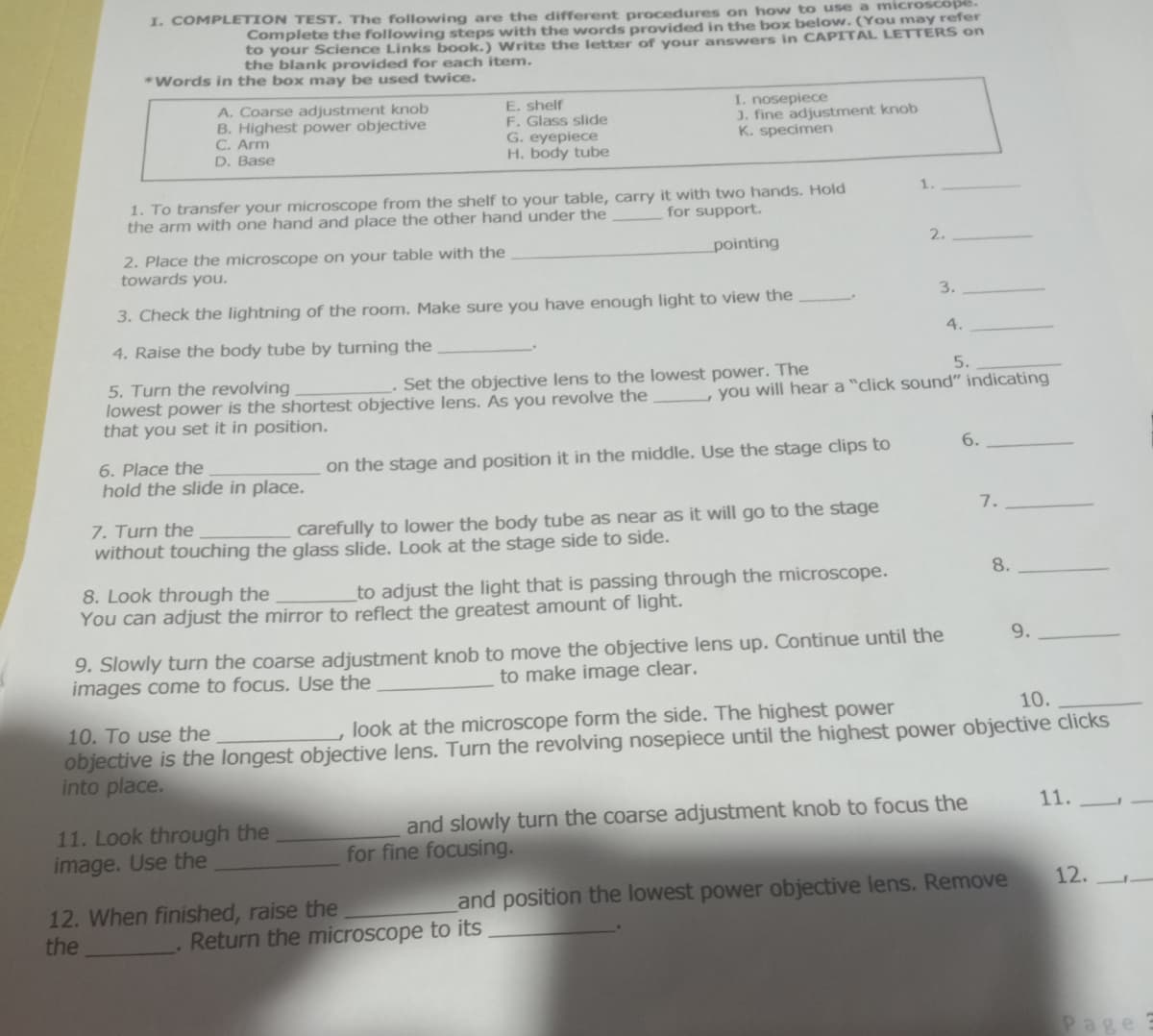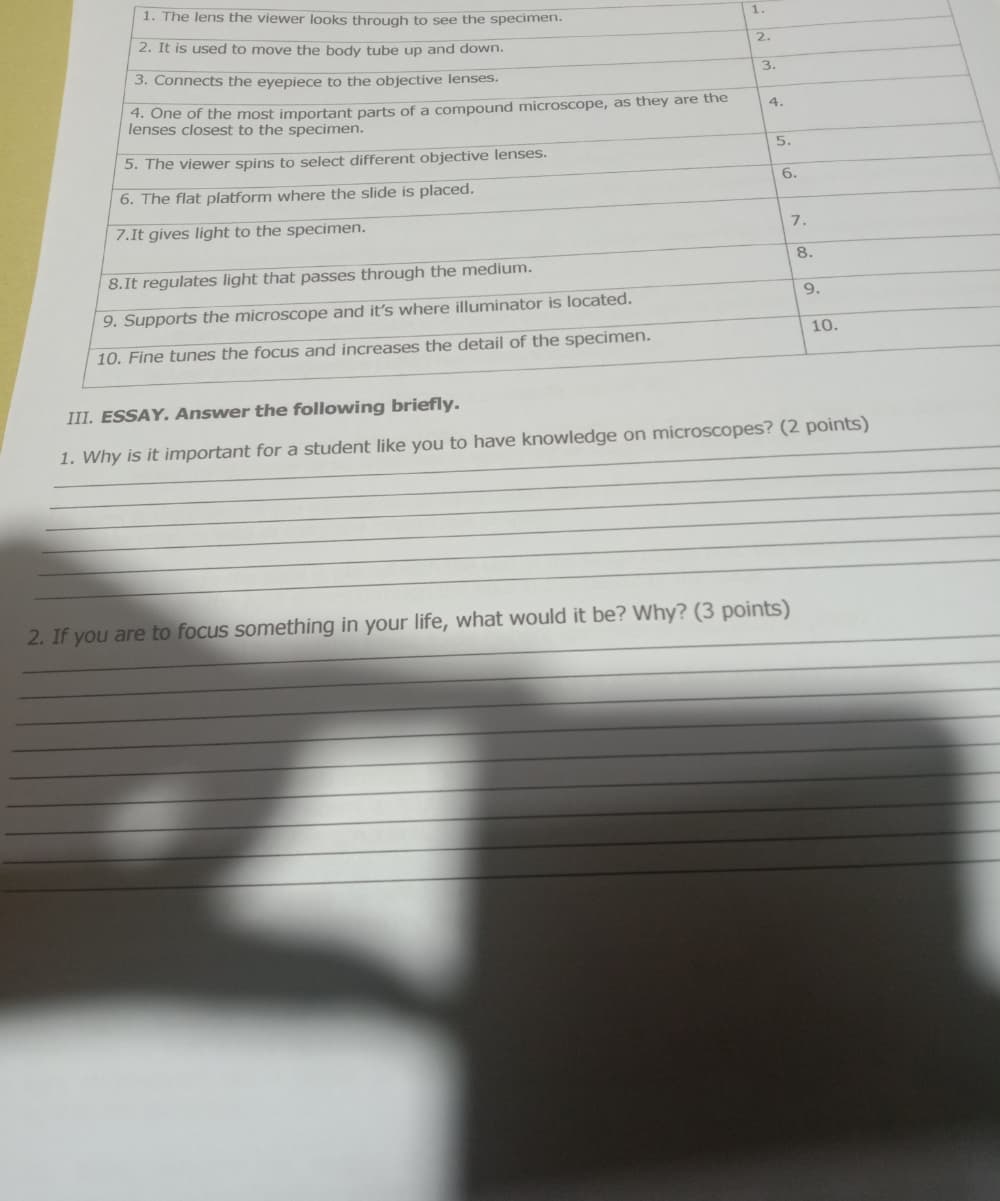L. COMPLETION TEST. The following are the different procedures on how to use a microscope. Complete the following steps with the words provided in the box below. (You may refer to your Science Links book.) Write the letter of your answers in CAPITAL LETTERS on the blank provided for each item. *Words in the box may be used twice. A. Coarse adjustment knob B. Highest power objective C. Arm D. Base E. shelf F. Glass slide G. eyepiece H. body tube I. nosepiece J. fine adjustment knob K. specimen 1. To transfer your microscope from the shelf to your table, carry it with two hands. Hold the arm with one hand and place the other hand under the 1. for support. 2. 2. Place the microscope on your table with the towards you. pointing 3. 3. Check the lightning of the room. Make sure you have enough light to view the 4
L. COMPLETION TEST. The following are the different procedures on how to use a microscope. Complete the following steps with the words provided in the box below. (You may refer to your Science Links book.) Write the letter of your answers in CAPITAL LETTERS on the blank provided for each item. *Words in the box may be used twice. A. Coarse adjustment knob B. Highest power objective C. Arm D. Base E. shelf F. Glass slide G. eyepiece H. body tube I. nosepiece J. fine adjustment knob K. specimen 1. To transfer your microscope from the shelf to your table, carry it with two hands. Hold the arm with one hand and place the other hand under the 1. for support. 2. 2. Place the microscope on your table with the towards you. pointing 3. 3. Check the lightning of the room. Make sure you have enough light to view the 4
Chapter9: Optics
Section: Chapter Questions
Problem 1MIO: The shell” of a concept map dealing with lenses and their properties is shown in Concept Map 9.2....
Related questions
Question
sorry for the misunderstanding sir/ma'am ...it stated biology instead of physics im really sorry.sir/ma'am
Can u please help me with this?sir/ma'am

Transcribed Image Text:I. COMPLETION TEST. The following are the different procedures on how to use a microscope.
Complete the following steps with the words provided in the box below. (You may refer
to your Science Links book.) Write the letter of your answers in CAPITAL LETTERS on
the blank provided for each item.
*Words in the box may be used twice.
A. Coarse adjustment knob
B. Highest power objective
C. Arm
D. Base
E. shelf
F. Glass slide
G. eyepiece
H. body tube
I. nosepiece
J. fine adjustment knob
K. specimen
1. To transfer your microscope from the shelf to your table, carry it with two hands. Hold
the arm with one hand and place the other hand under the
1.
for support.
2. Place the microscope on your table with the
towards you.
pointing
2.
3. Check the lightning of the room. Make sure you have enough light to view the
3.
4. Raise the body tube by turning the
4.
5. Turn the revolving
lowest power is the shortest objective lens. As you revolve the
that you set it in position.
Set the objective lens to the lowest power. The
5.
, you will hear a "click sound" indicating
6. Place the
on the stage and position it in the middle. Use the stage clips to
6.
hold the slide in place.
7. Turn the
without touching the glass slide. Look at the stage side to side.
7.
carefully to lower the body tube as near as it will go to the stage
8.
8. Look through the
You can adjust the mirror to reflect the greatest amount of light.
_to adjust the light that is passing through the microscope.
9. Slowly turn the coarse adjustment knob to move the objective lens up. Continue until the
images come to focus. Use the
9.
to make image clear.
10.
10. To use the
objective is the longest objective lens. Turn the revolving nosepiece until the highest power objective clicks
into place.
look at the microscope form the side. The highest power
and slowly turn the coarse adjustment knob to focus the
for fine focusing.
11.
11. Look through the
image. Use the
and position the lowest power objective lens. Remove
12.
12. When finished, raise the
the
Return the microscope to its

Transcribed Image Text:1. The lens the viewer looks through to see the specimen.
1.
2. It is used to move the body tube up and down.
2.
3. Connects the eyepiece to the objective lenses.
3.
4. One of the most important parts of a compound microscope, as they are the
lenses closest to the specimen.
4.
5. The viewer spins to select different objective lenses.
5.
6. The flat platform where the slide is placed.
6.
7.It gives light to the specimen.
7.
8.
8.It regulates light that passes through the medium.
9.
9. Supports the microscope and it's where illuminator is located.
10.
10. Fine tunes the focus and increases the detail of the specimen.
III. ESSAY. Answer the following briefly.
1. Why is it important for a student like you to have knowledge on microscopes? (2 points)
2. If you are to focus something in your life, what would it be? Why? (3 points)
Expert Solution
This question has been solved!
Explore an expertly crafted, step-by-step solution for a thorough understanding of key concepts.
This is a popular solution!
Trending now
This is a popular solution!
Step by step
Solved in 3 steps

Knowledge Booster
Learn more about
Need a deep-dive on the concept behind this application? Look no further. Learn more about this topic, physics and related others by exploring similar questions and additional content below.Recommended textbooks for you


Physics for Scientists and Engineers: Foundations…
Physics
ISBN:
9781133939146
Author:
Katz, Debora M.
Publisher:
Cengage Learning


Physics for Scientists and Engineers: Foundations…
Physics
ISBN:
9781133939146
Author:
Katz, Debora M.
Publisher:
Cengage Learning